
A Brief History of the Early Medicinal Books
Ancient Pharaceutical Writings
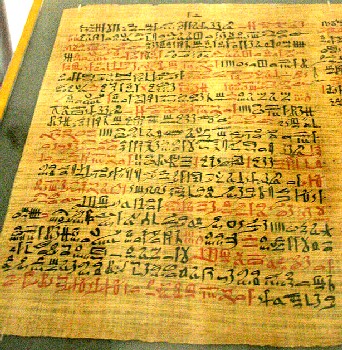
Ebers Papyrus, Column 41 (1500 BC)
The Sumerians are the first people to mention plants as sources of healing medications. The earliest such record discovered is a cuneiform tablet from Nipur (modern Iraq) dating to 2100 B.C. containing formulas and directions
for combining medicines.1 It contains a variety of folk and mystical cures.
A somewhat more scientific approach to treatments and medicines is found in the Ebers Papyrus, an Egyptian document from around 1550 B.C. "In this papyrus are mentioned over 700 different substances from the animal, vegetable and mineral kingdoms"2. They run the gamut from narcotics to purgatives to emollients [softening agents] to dentifrices to deodorants and everything in between.
The form of the medicines would have been quite familiar to a late 17th/early 18th century surgeon: pills, powders, potions, ointments and plasters.3
1Jules Janick, “Herbals: The Connection Between Horticulture and Medicine", HorTechnology, April-June, 2003, p. 130; 2,3 Carl H. Von Klein, The Medical Features of the Papyrus Ebers, Delivered before the 30th Annual Session of the American Academy of Medicines of Chicago, 1905, p. 10
The Impact of the Revered Ancients on Medicinals
Seventeenth and eighteenth century books about medicine nearly always calls back to the revered ancient writers upon which much of their medical theory was based.
Hippocrates is often considered the father of medicine, particularly as it was practised in the golden age of piracy. However, Leslie Matthews points out that "the Hippocratic corpus [places] less
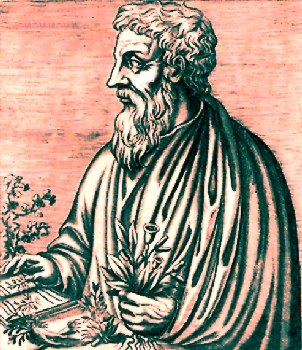
Pedanius Dioscorides
emphasis than would be expected upon the actual drugs to be used. It seems that the physicians for whom Hippocrates wrote were expected to know what to prescribe in the more usual cases and therefore only occasionally are special therapeutic indications given."1
The remedy book that impacted most of the herbals and dispensatories written in the next fifteen centuries was Pedanius Dioscorides' 1st century A.D. book De Materia Medica (On Medical Materials). Dioscorides was a Roman army surgeon specializing in the study of drugs and their uses. He "had considerable knowledge of the use and preparation of the drugs he described"2 and explains their use from both the herbal and medical perspectives. "De Materia Medica described hundreds of pharmaceutical preparations made from vegetable, animal, and mineral sources"3, while also giving "formulae for a wide variety of pharmaceutical preparations.”4 It continued to be widely used and was translated into Latin, Greek, and Arabic.5
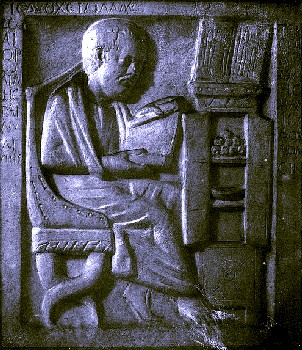
Greco-Roman Physician in His Study
From the Wellcome Collection
Outside of medicinals, Dioscorides is not widely mentioned in golden age of piracy era books. Second century physician Galen of Pergamon is far more frequently found, particularly because of his emphasis on the theory of humors, which postulated that that body contained four fluid humors that controlled the health of the individual.
In addition to promoting the humoral theory of medicine, Galen was "an acknowledged master in the formulation of remedies... [who] paid great attention to care in the choice of ingredients."6 Galen stocked his own pharmacy, which "contained hundreds of medicines made from animal and vegetable ingredients."7 He advised the use of the best examples of plant procured from recognized medicinal sources, also suggesting which were the most potent parts."The chief forms in which the therapeutic agents were administered were decoctions, electuaries, pills, plasters, and ointments."8
1 L.G. Matthews, Footnote, “Herbals and Formularies”, From The Evolution of Pharmacy in Britain, Edited by F.N.L. Poynter, 1965, p. 201; 2 Matthews, p. 202-3; 3 Christopher W. Koehler, “Pharmacopoeias”, Modern Drug Discovery, November 2002, p. 53; 4 Matthews, p. 187; 5 "Pedanius Dioscorides: De Materia Medica", wikipedia, gathered 4/8/15; 6 Matthews, p. 203; 7 Koehler, p. 53; 8 Matthews, p. 203;
Early English Medicine - The Romans and the Medieval Pharmacy
English medicines and pharmacopoeias had many of their roots in Roman medicines. "The Roman military had agreed lists of medicines when they came to England. Scribonius Largus, court physician to the emperor Claudius, brought with him his Compositiones Medicamentorum, a list of 271 prescriptions for use by the army medical service. On the departure of the Romans in the fifth century the keeping of such compendia fell mainly to the monasteries.”1
With the church being primarily in charge of medical 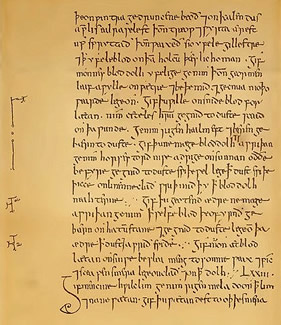
Page from Bald's Leechbook, From Leechdoms,
Wortcunning and Starcraft of Early England (10th c.)
knowledge in England, regular people were largely left to their own devices when it came to medicinals. As Christopher Koehler puts it, "medieval pharmacy was much more a matter of local remedies."2 However, medicinal books were still kept, the ninth century Old English Bald's Leechbook being an example. It contains three books, the first two of which deal with illnesses of the external and internal body and the last of which "is a collection of medical recipes, of lesser scholarly import"3.
The cures in the Leechbook are folksy to say the least. By way of example one suggestion reads, "If a thorn or a reed prick a man in the foot, and will not be gone; let him take a fresh goose turd and green yarrow [Achillea millefolium], let him pound them thoroughly together, paste them on the wound, soon it will be well."4 Yet such elements were still found in the celebrated pharmacopoeias eight centuries later. There may even be merit in some of these remedies. The recipe for treating a wen (stye), which included "cropleek and garlic... wine and bullocks gall"5, was tested for stye treatment by microbiologist Freya Harrison and Christina Lee, an Anglo-Saxon scholar. They reported that it "seems to alleviate infections caused by the bacteria that are usually responsible for styes."6
1 Stuart Anderson, Pharmacopoeias of Great Britain, International Society for the History of Pharmacy, www.histpharm.org, gathered 3/20/15, p. 1; 2 Christopher W. Koehler, “Pharmacopoeias”, Modern Drug Discovery, November 2002, p. 53; 3 M.L. Cameron, "Bald's Leechbook: its sources and their use in its compilation", Anglo-Saxon England, Vol. 12, December 1983, p. 153;4 Leechdoms, wortcunning, and starcraft of early England, Vol. II (Bald's Leechbook), edited by Rev. Oswald Cockayne, p. 337; 5 Leechdoms, p. 35; 6 Clare Wilson, "Anglo-Saxon remedy kills hospital superbug MRSA", NewScientist.com, gathered 4/9/15
The Arabic Impact on Medicinal Books
Much of the methodical development of medicine in the ninth through eleventh centuries 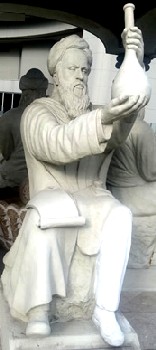
Photo: Wiki User Yamaha5
Rhazes, At Persian Scholar
Pavilion, Vienna UN was focused in the Arabic countries. Books from these places had a great deal of impact on future medicinal writers. The seventeenth and eighteenth century dispensatories reference authors such as the Persian Rhazes (Muhammad ibn Zakariyā Rāzī, 854 - 925 A.D.), author of a textbook of medicine and surgery called Kitab al-hawi (Liber continens); the Syrian Mesue the Younger (Masawaih al-Mardini, 925 - 1015 A.D), attributed author of De medicins laxativis and the Antidotarium sive Grabadin medicamentorum containing prescriptions for compound medicines which was "used in the compilation of almost every state or city pharmacopoeia"1; the Persian Avicenna (Abū ʿAlī al-Ḥusayn ibn ʿAbd Allāh ibn Al-Hasan ibn Ali ibn Sīnā, 980-1037), author of the Canon of Medicine containing about 800 simple medicines including plant, animal and substances as well as 650 compound drugs.2
Many of the Arab physicians believed in combining elements to create polypharmacueticals - the recipes for which survived into and beyond the golden age of piracy. Both Avicenna and Mesue the Younger promote such "'grand compositions', those blunderbuss preparations of thirty or more ingredients, especially the soft or semi-soft electuaries containing numerous aromatic and mineral substances”3. Rhazes was the exception, preferring not to give medications at all unless necessary, He advised his reader when "he must use medication, then it should be simple remedies and not compound ones.”4
1 L.G. Matthews, “Herbals and Formularies”, From The Evolution of Pharmacy in Britain, Edited by F.N.L. Poynter, 1965, p. 204; 2 "The Cannon of Medicine", wikipedia, gathered 4/9/15; 3 Matthews, p. 204; 4 Rhazes, cited by Selma Tibi, "Al-Razi and Islamic medicine in the 9th Century", jameslindlibrary.org, gathered 4/9/15;
The School of Medicine in Salerno
The center of medical progress shifted to Italy sometime around the 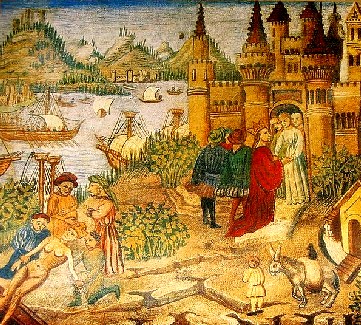
Schola Medica Salernitan, From Avicennas Canons
twelfth century. The School of Medicine in Salerno is believed to have opened some time in the 8th century, gradually becoming "the seat of a guild of physicians, attracting not only patients but also students."1 Many Englishmen were trained in the practice of medicine and pharmacy here2, which started out drawing upon the Hippocratic works, but gradually began to adopt the Arabic works thanks their translation into Latin by Constantine the African in the 11th century.3
A important work for European pharmacy was English physician Gilbertus Anglicus' mid-13th-century Compendium of Medicine. Anglicus was a student of the Salerno school and his work reflected that. The Compendium, published some time after 1230 A.D, comprised seven books which detailed illness diagnosis and prognosis as well as prescriptions for numerous drugs which were produced from 400 different medicinal ingredients.4 Anglicus quotes other medical writers extensively, including Hippocrates, Galen, Rhazes, Avicenna and writers from the School of Medicine of Salerno.5 "The Compendium was translated into English in the early 15th century, indicating, perhaps, that apothecaries increasingly distinguished themselves from others who sought to govern health.”6
1 Kremers and Urdang’s History of Pharmacy, 4th ed., Edited by Glenn Sonnedecker, p. 32; 2 L.G. Matthews, “Herbals and Formularies”, From The Evolution of Pharmacy in Britain, Edited by F.N.L. Poynter, 1965, p. 204; 3 Kremers and Urdang, p. 32; 4 Christopher W. Koehler, “Pharmacopoeias”, Modern Drug Discovery, November 2002, p. 53 & "Gilbertus Anglicus", wikipedia.com, gathered 4/9/15; 5 "Gilbertus Anglicus", gathered 4/9/15; 6 Koehler, p. 53;
Early English Herbals
 variety of privately produced herbals were produced in the late 16th and early 17th century which impacted writings on medicine.
variety of privately produced herbals were produced in the late 16th and early 17th century which impacted writings on medicine.
The first book of this nature in England was Richard Banckes' Herball, printed in 1525. In it, Banckes discusses "some 250 herbs describing them as "hot", "dry", etc. in their various degrees and he seems to have had some understanding of pharmaceutical operations”1. The material in Banckes book was widely 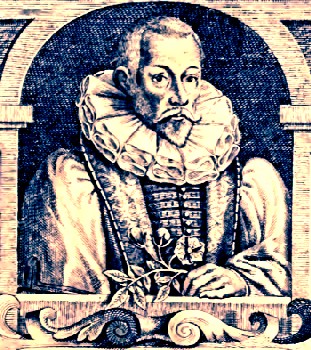
John Gerard, From the Frontispiece of his Herbal (1636)
copied and reprinted.2
Another important early English herbal was John Gerard's Herball or Generall Historie of Plantes first printed in 1597. Gerard was a Cheshire-born gardener, botanist and member of the Barber-Surgeons' Company of London, who "may have acted as ship's surgeon during the time that he travelled, as he says, from Narva to Moscovia and to Denmark, Swenia, Poland, etc."3
His book consists of 1400 folio pages where he "set downe not only the names of sundry Plants but also their natures, their proportions and properties, their affects and effects, their increase and decrease, their flourishing and fading, their distinct varieties and severall qualities"4. The book was enlarged and reprinted in 1633.
Such herbals "helped greatly in the identification of the herbs used in medicine, the uses of which were made available to a wide public, and all in all they were a valuable addition to the medical literature of their period."5
1 L.G. Matthews, “Herbals and Formularies”, From The Evolution of Pharmacy in Britain, Edited by F.N.L. Poynter, 1965, pp. 197; 2 Agnes Arber, Herbals, Their Origin and Evolution, 1912, p. 39; 3 Matthews, p. 194-5; 4 John Gerard, "To the Reader", The Herball or Generall Historie of Plantes, 1636, not paginated; 5 Matthews, p. 200
The City Pharmacopoeias
Around the same time, books of medicine began to take on 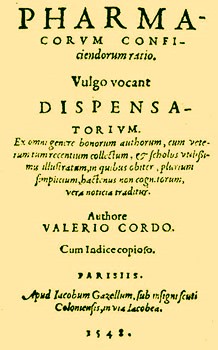
Dispensatorium Pharmacorum Omnium
(Homely, Isn't it?) (1546)
an air of authority, being backed, published, and enforced by the physicians in various cities. Such books were usually called pharmacopoeias. The word 'pharmacopeia' was derived from ancient Greek and basically meant 'drug making'.1
Pharmacist and historian George Urdang wrote that the first such pharmacopoeia was the Florentine Nuovo Receptario Composito (1498).2 In contrast, Professor Douglas Dunlop declares that the first book "with the imprint of authority was probably the Dispensatorium Pharmacorum Omnium issued in 1546 with the sanction of the Senate of Nuremberg.”3
Other publications which were officially recognized by local groups of apothecaries include the Augsburg Enchiridion sive Dispensatorium (1564) and the Dispensarium Reipublicae Coloniensis (1565).
Theodor Huseman, a professor of pharmacology and toxicology at the University of Göttingen, Germany explained that the wave of such 'official' books actually represented ''the orthodox teaching of medicine as contrasted with that of Paracelsus and his followers, who raged against the teachings of Greek and Arabic medicine."4
The arrival of the official pharmacopoeias set the stage for the English book that would be used by the dispensatory writers of the late 17th and early 18th centuries as a basis for their books: the London Pharmacopoeia. To learn more about the publication of this important book, see this page of article The Sea Surgeon's Dispensatory.1 L.G. Matthews, Footnote, “Herbals and Formularies”, From The Evolution of Pharmacy in Britain, Edited by F.N.L. Poynter, 1965, p. 208-9; 2 George Urdang, "How Chemicals Entered the Official Pharmacopoeias", Transactions of the Wisconsin Academy of Sciences, Arts and Letters, Vol. XXXIX (1947-1949), Banner Bill Morgan, ed., p. 115; 3 D.M. Dunlop, “The History and Development of the “British Pharamopoeia””, British Medical Journal, Nov. 22, 1958, p. 1250; 4 George Urdang, p. 115

